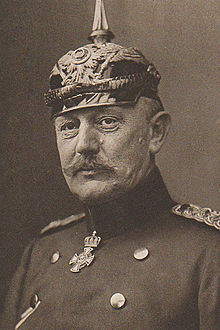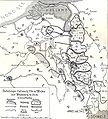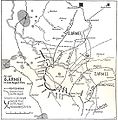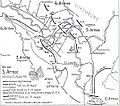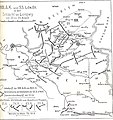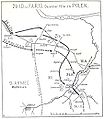Commanders and locations of the German Army
The overall commander of the Imperial German Army was Kaiser Wilhelm II. The Chief of the General Staff was Generaloberst Helmuth von Moltke the Younger, with General Hermann von Stein as Deputy Chief. The Departmental chiefs were Oberst Tappen (Operations Branch), Oberstleutnant Hentsch (Intelligence Branch), Major Nicolai (Secret Service), Oberst von Dommes (Political Section), Generalleutnant Siger (Field munitions), Major Thomsen (Air Service), Oberst Groner (Field Railways), General von Lauter(Foot Artillery), General von Claer was General of Engineers, and General von Schjerning (Medical Services). Generalmajor von Schoeler was Intendant-General (responsible for logistical supplies). [1]
Helmuth von Moltke the Younger
Location of the German divisions 1914
Location of the German brigades 1914
Homeland corps deployments (1871-1914)
During times of war in Germany, all military forces came under the direct command of the German Emperor, via Article 60 of the Constitution of the German Reich (1871). From 1871 to 1918, the forces of the Emperor included those of the kingdoms of Prussia, Bavaria, Saxony and Württemberg, with all other states commanded by, or merged with his Prussian army.
Battle of the Frontiers - 2 August to 26 August 1914.
German corps areas 1914
March in the West
Situation in East
March Württ. Troops 1914
7th German Army in August 1914
6th Army August 1914
5th Army August 1914
XIII. AK Longwy 1914
XIII. AK Maas 1914
XIII. AK Argonne 1914
26th Kav.Brig 1914
26th (Württ) and 28th Württ. Res Div. End September 1914
Lw-Regt. 122 Lorraine 1914
51st Ers.Brig 1914
26th Inf Div. and 26th Cavalry Brig. 1914
26th Inf.-Div. and FArt-Regt. 13 Poland 1914
Württ. units at Western Front in late 1914
Württ. units at Eastern Front in late 1914
Western Front
Second Army
2nd Army had the following order of battle: [5]
Commander: Generaloberst Karl von Bülow
Chief of Staff: Generalleutnant Otto von Lauenstein
Oberquartiermaster: Generalmajor Erich Ludendorff
HQ: Monschau, Germany
Strength: 260,000
Commander: General der Infanterie Karl von Plettenberg
Chief of Staff: Oberstleutnant Friedrich Graf von der Schulenburg
- 1st Guards Infantry Division (Generalleutnant Oskar von Hutier)
- 1st Guards Infantry Brigade (Generalmajor Friedrich Leopold von Kleist)
- 2nd Guards Infantry Brigade (Generalmajor Hans Karl Schach von Wittenau)
- 1st Guards Field Artillery Brigade (Generalmajor Friedrich von Buddenbrock)
- Leib-Garde-Husaren-Regiment (Oberst Georg von Brandenstein)
- 2nd Guards Infantry Division (Generalleutnant Arnold von Winckler)
- 3rd Guards Infantry Brigade (Generalmajor Viktor Albrecht)
- 4th Guards Infantry Brigade (Generalmajor Friedrich von Gontard)
- 2nd Guards Field Artillery Brigade (Generalmajor Joseph Trimborn)
- 2. Garde-Ulanen-Regiment (Oberstleutnant Leopold von Maltzahn)
Commander: General der Infanterie Otto von Emmich
Chief of Staff: Oberst Gustav von der Wenge Graf von Lambsdorff
Commander: General der Artillerie Max von Gallwitz
Chief of Staff: Oberst Paul von Barttenwerffer
- 3rd Guards Infantry Division [6] (Generalleutnant Henning von Bonin)
- 5th Guards Infantry Brigade (Generalmajor Nikolaus von Below)
- 6th Guards Infantry Brigade (Generalmajor Friedrich von Friedeburg)
- 3rd Guards Reserve Field Artillery Brigade (Generalmajor Hans Willibald Graf von Schweinitz und Krain Frh von Kauder)
- Guards-Reserve-Ulanen-Regiment (Major Johan Cesar Godefroy-Faerber)
- 1st Guards Reserve Division (Generalmajor Viktor Albrecht)
- 1st Guards Reserve Brigade (Generalmajor Hans Frh von Langermann und Erlenkamp)
- Garde-Reserve-Infanterie-Regiment Nr. 1 (Oberstleutnant Max Friedrich von Schlechtendal)
- Garde-Reserve-Infanterie-Regiment Nr. 2 (Oberstleutnant Wigand von Cramer)
- Garde-Reserve-Jäger-Bataillon (Major von Gluszewski)
- 15th Reserve Infantry Brigade (Oberst Hans von Below)
- Reserve-Infanterie-Regiment Nr. 64 (Oberstleutnant Rudolf von Cramer)
- Reserve-Infanterie-Regiment Nr. 93 (Oberst von Jena)
- Guards Reserve Field Artillery Brigade (Generalmajor Louis Mertens)
- Garde-Reserve-Feldartillerie-Regiment (Oberstleutnant von Bülow)
- 3. Garde-Reserve-Feldartillerie-Regiment (Oberstleutnant Goling)
- Garde-Reserve-Dragoner-Regiment (Major von Hofmann)
Commander: General der Infanterie Hans von Zwehl
Chief of Staff: Oberstleutnant Hans Hesse
- 13th Reserve Division (Generalleutnant Alfred von Kühne)
- 25th Reserve Infantry Brigade (Generalleutnant Andreas Wilhelm von Harbou)
- Reserve-Infanterie-Regiment Nr. 13 (Oberstleutnant Johann Edler und Ritter von Braun)
- Reserve-Infanterie-Regiment Nr. 56 (Oberstleutnant von Goetze)
- 28th Reserve Infantry Brigade (Generalmajor Karl Johann Neuhauß)
- Reserve-Infanterie-Regiment Nr. 29 (Oberstleutnant Eben)
- Reserve-Infanterie-Regiment Nr. 37 (Oberstleutnant von Flottwell)
- Reserve-Jäger-Bataillon Nr. 7 (Hauptmann von der Groeben)
- Reserve-Feldartillerie-Regiment Nr. 13 (Oberstleutenant Reinecke)
- Reserve-Husaren-Regiment Nr. 5 (Major Hugo von Kayser)
- 14th Reserve Division (Generalleutnant Wolfgang von Unger)
- 28th Infantry Brigade (Oberst Hermann von Ziegesar)
- Niederrheinisches Füsilier-Regiment Nr. 39 (Oberst Walter von Schönberg)
- 8. Lothringisches Infanterie-Regiment Nr. 159 (Obserst Karl von Kraewel)
- 27th Reserve Infantry Brigade (Generalleutnant Edwin Sunkel)
- Reserve-Infanterie-Regiment Nr. 16 (Oberstleutnant Siegener)
- Reserve-Infanterie-Regiment Nr. 53 (Oberstleutnant Bötterling)
- Reserve-Feldartillerie-Regiment Nr. 14 (Major Wendt)
- Reserve-Husaren-Regiment Nr. 8 (Major Heyne)
Other Forces
- 25th Mixed Landwehr Brigade (Georg Franz von Glasenapp)
- 29th Mixed Landwehr Brigade (Viktor von Rosenberg-Lipinski)
- 4 Mortar Battalions [7]
- 10-cm Gun Battalion [8]
- 2 Heavy Coastal Mortar Batteries [9]
- 2 Pionier Regiments [10]
Third Army
3rd Army had the following order of battle: [11]
Commander: Generaloberst Max von Hausen
Chief of Staff: Generalmajor Ernst von Hoeppner
Oberquartiermaster: Generalmajor Max Leuthold
Commander of Pioniere: Generalmajor Franz Adams
HQ: Prüm, Germany
Strength: 180,000
Commander: General der Artillerie Hans von Kirchbach
Chief of Staff: Oberstleutnant Konrad von Koppenfels
Other Forces
- 47th Mixed Landwehr Brigade (Generalleutnant ch. Carlotto Graf Vitzthum von Eckstaedt)
- Mortar Battalion [12]
- Pionier Regiment [13]
Seventh Army
7th Army had the following Order of Battle: [25]
Commander: Generaloberst Josias von Heeringen
Chief of Staff: Generalleutnant Karl von Hänisch
Oberquartiermeister: Generalmajor Ernst von Zieten
Commander: General der Artillerie Richard von Schubert
Chief of Staff: Oberstleutnant Bernhard Bronsart von Schellendorff
Other Forces
- 19th Ersatz Division
- Bavarian Ersatz Division
- 60th Mixed Landwehr Brigade
- Upper Rhine Fortifications
- 55th Mixed Landwehr Brigade
- 110th Reinforced Landwehr Infantry Regiment
- 1st Bavarian Mixed Landwehr Brigade
- 2nd Bavarian Mixed Landwehr Brigade

This article details the order of battle of German military units during the invasion of Poland in 1939.
The order of battle for the Battle of France details the hierarchy of the major combatant forces in the Battle of France in May 1940.
The Alpenkorps was a provisional mountain formation of division size formed by the Imperial German Army during World War I. It was considered by the Allies to be one of the best in the German Army.
The 3rd Division was a unit of the Prussian/German Army. It was formed in Stettin in May 1816 as a Troop Brigade (Truppen-Brigade). It became the 3rd Division on September 5, 1818. From the corps' formation in 1820, the division was subordinated in peacetime to the II Army Corps. The 3rd Division was disbanded in 1919 during the demobilization of the German Army after World War I.
The 52nd Infantry Division (52.Infanterie-Division) was a division of the Imperial German Army during World War I. The division was formed on March 6, 1915, from units taken from other divisions or newly raised. The division was initially mixed, with two infantry regiments from the Grand Duchy of Baden, one infantry regiment from Prussian Saxony, and Prussian and Baden support units. While the infantry regiments and the divisional cavalry squadron were regular army units, the rest of the division was made up of reserve units and units formed during the war. The 66th Magdeburg Infantry Regiment was taken from the 7th Infantry Division, and the 169th and 170th Infantry Regiments were taken from Baden's 29th Infantry Division. The 52nd Infantry Division became more Baden as the war progressed, as the 66th Magdeburg Infantry Regiment, the regiment from Prussian Saxony, was replaced on April 6, 1917, by Baden's 111th Infantry Regiment "Margrave Ludwig Wilhelm".
The Bavarian Ersatz Division was a Bavarian division of the Imperial German Army in World War I. It was formed in August 1914 and dissolved on 6 October 1918. It was initially a Bavarian formation but soon received several non-Bavarian units which served with the division until 1917.
The 25th Division, officially the Grand Ducal Hessian (25th) Division, was a unit of the Prussian/German Army. It was headquartered in Darmstadt, the capital of the Grand Duchy of Hesse. The division was subordinated in peacetime to XVIII Army Corps when that corps was formed in 1899. The division was disbanded in 1919, during the demobilization of the German Army after World War I.
This is an order of battle of the French and German Armies at the beginning of the Franco-Prussian War in 1870.
The 8th Landwehr Division was a unit of the Prussian/German Army. The division was formed on January 31, 1915, out of the formerly independent 56th Landwehr Infantry Brigade, which had been dissolved on January 25, 1915. The division spent the period from its formation to early 1917 mainly involved in positional warfare in Upper Alsace, after which it occupied the trenchlines near Verdun. It remained in positional warfare in this general region until the end of the war. It participated in no major battles, but was primarily suited to quieter sectors of the line. Allied intelligence rated the division as a fourth class division, though it noted that "in the attack it did fairly well, without heavy loss." The division was disbanded in 1919 during the demobilization of the German Army after World War I.
The 5th Royal Bavarian Division was a unit of the Royal Bavarian Army which served alongside the Prussian Army as part of the Imperial German Army. The division was formed on October 1, 1890, in Landau as the 5th Division and swapped division numbers with the Nuremberg-based 3rd Royal Bavarian Division in 1901. In Bavarian sources, it was not generally referred to as a "Royal Bavarian" division, as this was considered self-evident, but outside Bavaria, this designation was used for it, and other Bavarian units, to distinguish them from similarly numbered Prussian units. The division was part of the III Royal Bavarian Army Corps.
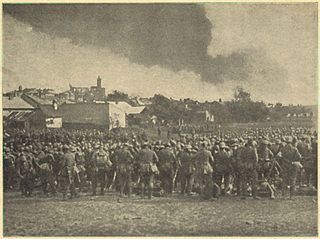
The 3rd Landwehr Division was an infantry division of the Imperial German Army during World War I. It was formed on the mobilization of the German Army in August 1914 under the "Higher Landwehr Commander 3". The Landwehr was the third category of the German Army, after the regular Army and the reserves. Thus Landwehr divisions were made up of older soldiers who had passed from the reserves, and were intended primarily for occupation and security duties rather than heavy combat. While the division was a Landwehr formation, at the beginning of the war it also had an attached Ersatz infantry brigade, made up of cadres from various regimental replacement battalions. The division was primarily raised in the Prussian provinces of Posen, Lower Silesia, and West Prussia. The division was disbanded in 1919 during the demobilization of the German Army after World War I.

The 4th Landwehr Division was an infantry division of the Imperial German Army during World War I. It was formed on mobilization of the German Army in August 1914 under the "Higher Landwehr Commander 4". The Landwehr was the third category of the German Army, after the regular Army and the reserves. Thus Landwehr divisions were made up of older soldiers who had passed from the reserves, and were intended primarily for occupation and security duties rather than heavy combat. The division was primarily raised in the Prussian provinces of Upper and Lower Silesia. It was disbanded in 1919 during the demobilization of the German Army after World War I.
The 85th Landwehr Division was a unit of the Imperial German Army in World War I. The division was formed in November 1914 as the Breugel Division, named after its commander, Generalleutnant Willem Hendrick Clifford Kocq von Breugel, and became the 85th Landwehr Division on 13 September 1915. The division was disbanded in 1919 during the demobilization of the German Army after World War I. The Landwehr was the third category of the German Army, after the regular Army and the reserves. Thus Landwehr divisions were generally made up of older soldiers who had passed from the reserves, and were intended primarily for occupation and security duties rather than heavy combat.
The 89th Infantry Division was a formation of the Imperial German Army in World War I. The division was formed in November 1914 as the provisional Westernhagen Division, named after its commander. The nucleus of the unit was troops collected at Posen. It became the 89th Infantry Division in August 1915. The division was disbanded in 1919 during the demobilization of the German Army after World War I.
The 1st Bavarian Landwehr Division was a unit of the Bavarian Army, part of the Imperial German Army, in World War I. The division was formed on August 21, 1914, as the "Reinforced Bavarian Landwehr Division" and was also known initially as the Wening Division, named after its commander, Otto Wening. It became the 1st Bavarian Landwehr Division in September 1914. The division was disbanded in 1919 during the demobilization of the German Army after World War I.
The following units of the British, French and German Empires fought in the First Battle of the Marne from 5–12 September 1914 on the Western Front of World War I.
The following units and commanders took part in the Battle of Königgrätz on July 3, 1866. Compiled from the Prussian Army's Official History of the war.
The First Army was a Prussian formation during the Austro-Prussian War. Being a wartime organization of the Prussian Army; it afterwards was demobilized.
The Second Army was a formation of the Prussian Army during the Austro-Prussian War. Being a wartime formation, afterwards the field army was demobilized.
Ernst August Anton Hermann Otto von Lauenstein was a Prussian Generalleutnant who served during World War I. He was chief of staff of the 2nd Army and later commanded the XXXIX Reserve Corps.
